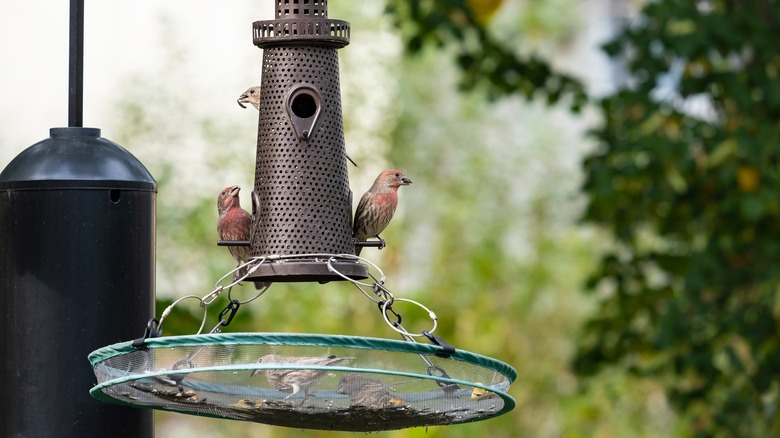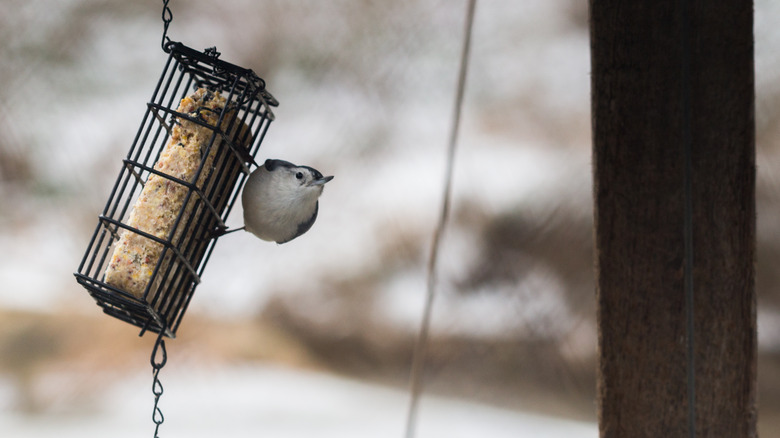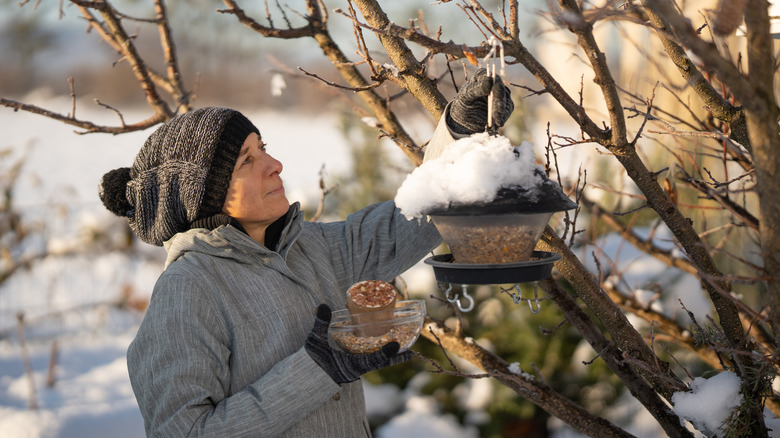Are Metal Bird Feeders Safe To Leave Out In The Winter?
While the old adage says that birds fly south for winter, not all of our feathered friends leave the premises for warmer weather. Species from finches to cardinals to sparrows stay all year round, even when the temperatures plummet. It's important to give these non-migratory birds a source of food during a season when it's difficult for them to forage, which is why it's recommended to leave your birdfeeders up during winter — it helps local birds survive into spring. However, you might be wondering whether you should swap out your metal feeder for a plastic one to avoid freezing their feet. Thankfully, it turns out that metal feeders will do no damage to our feathered friends, even when there is moisture present.
Most people avoid touching metal outside when temperatures are frigid to avoid getting stuck. Any moisture on your hand or the pole can quickly turn into ice, sticking you to the metal surface. But you don't need to be worried that the same thing will happen to birds that perch on the metal feeder while poking away at seeds and nuts; the way their feet and legs are constructed helps birds avoid that fate. A closer look at their anatomy shows why.
Why birds won't stick to cold metal birdfeeders
Birdfeeders take a lot of abuse during the winter — they can very easily become coated in snow and ice, which means there is a lot of moisture present on the metal. This might make you worry that birds will stick to it, harming themselves when they try to unglue themselves and fly away. However, since their legs and feet are scaly, they won't suffer that fate. "Our fingers may stick to metal ice cube trays because moisture freezes on contact with frigid metal. However, a bird's feet are covered with dry scales, so there is no surface moisture to freeze to metal perches," ornithologist Steve Kress told Audubon Magazine. "Eyes, tongues, and beaks are usually safe from exposure to metal feeder parts. Rapid reflexes prevent the eye from coming in contact with foreign surfaces, and the beak is protected by a horny, dry surface."
As it turns out, birds don't get frozen feet sitting on cold metal for that same reason. Their feet are mostly comprised of bones and fibrous tendons, which means there isn't much liquid that can freeze, and they don't get much feeling in those extremities. If they do become uncomfortable in exceptionally cold temperatures, you will often see birds folding one leg underneath their feathers to warm it up while balancing on the second one. But generally, a cold metal perch won't bother them, meaning your metal birdfeeder doesn't pose a danger to them in the winter.
Precautions to take with winter birdfeeders
While you don't have to swap out your metal birdfeeder just because it's winter, it still might be a good idea to change your feeder if it doesn't meet certain cold-weather criteria. For example, if your apparatus doesn't have a wide lid that acts as a roof on top, it would be beneficial for your neighborhood birds to buy one that does. The lid creates a small shelter that can help block the visiting birds from the worst of the winds, and it also helps keep snow from accumulating on the feeding tray below.
You'll also want to ensure that your feeder has drainage holes on the bottom of the feeding tray so any trapped snow or ice has a way to drip out. If it doesn't, the water can pool and eventually spoil the seed inside the container. This can lead to mold growth, which can promote illnesses in any birds that eat it. To avoid that, ensure your birdfeeder has proper drainage holes. If you keep these tips in mind, you'll attract birds to your yard during the winter season and help keep them healthy all season long, no matter what material your feeder is made from.


